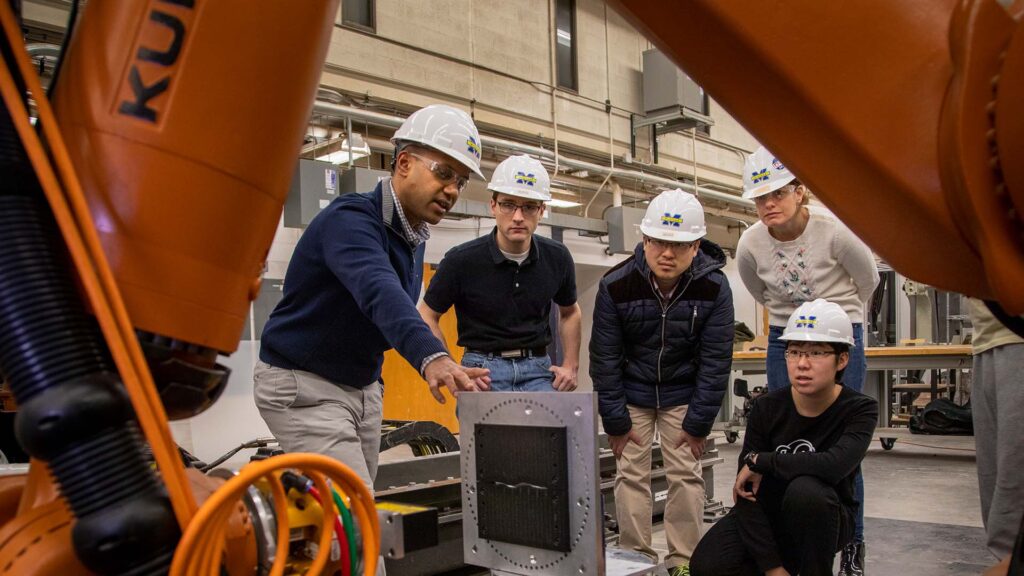
Q&A: U-M CEE Engineers at the Forefront of Construction Automation
Professors Menassa and Kamat explain how they are developing autonomous solutions in the field

Professors Menassa and Kamat explain how they are developing autonomous solutions in the field
CEE professors and leaders in automation and robotics in building and infrastructure environments, Professor and John L. Tishman Construction Management Faculty Scholar Carol Menassa and John L. Tishman Family Professor of Construction Management and Sustainability Vineet Kamat have been collaborating on research that aims to highlight how robots can be used as assistants to construction workers on construction jobs and improve the human experience. In this Q&A, Professors Menassa and Kamat discuss the future of automation and robotics in construction and how CEE and the University of Michigan can help lead the way.
What are some promising robotics technologies currently being used in the field of construction?
Kamat: Currently, the use of automation and robotics in construction is varied. In terms of heavy, outdoor construction, there are situations where fully automated equipment are deployed driverless, operating entirely on their own. If we look at urban construction, the introduction of automation and robotics technologies has been a little bit more fragmented and focused primarily on assistive devices, such as augmenting cranes or lifting devices. A large-scale deployment of automation and robotics in this context is still a very active area of research, primarily because of the complexities involved in construction.
Menassa: In addition to the technologies that are now being deployed on construction jobs, there has been a lot of advancements in the fields of machine learning, artificial intelligence and applications of virtual reality, augmented reality that are opening more doors for us to explore how robotics can be integrated in construction jobs to improve efficiency, improve safety, and reduce waste, and reduce the number of injuries that could be experienced on job sites.

What impact does automation have on construction site safety and worker well-being overall?
Menassa: One major impact we particularly see from our research is the fact that automation could potentially lead to a reduction in the number of injuries or fatalities on a construction job. The introduction of robotics in construction jobs can take away the physical burden and repetitive nature of the work and allow the workers to focus on being creative in their job. This could potentially increase their opportunities to work longer periods of time, reduce injuries and create a better quality of life for them.
Kamat: Every construction task can be thought of as consisting of three components or three elements. One is the planning aspect, the second is the cognitive aspect and the third is the physical aspect. The emphasis of our research right now is to explore whether we can make robots intelligent enough to take away some of the cognitive and planning burden off from construction workers as well as the physical aspect so that the human and robot team can work more efficiently, more productively and more safely.
What are some of the challenges you see in integrating these automated systems into the current traditional construction workflows that exist today?
Kamat: The overarching challenge in introducing robotics in construction is that every construction project is unique. So, the research that we’ve generally been conducting is centered around how we can make construction robots mobile and self-aware of their location, position and construction site, so that they can situate themselves in that environment and understand what value they can add in the next tasks they can perform.
Menassa: Another important challenge for the adoption of automation in construction jobs is the fact that construction jobs are usually done under very tight schedules and budget constraints. So, typically, construction is one of the industries that has been slow to adopt technologies and automation because of these challenges that make it hard to experiment and try new things. And so it’s very important to think about the contractual arrangements, making sure that the adoption of these technologies come from the top down.
Automation, when implemented correctly on construction jobs, would reduce waste, allow for repetitive tasks to be done in a more efficient way and allow the human worker to be in a supervisory collaborative role with the robot who is doing the job. There is potential for automation to lead to shorter time periods for different construction activities. And that in turn would imply reduced costs on construction jobs. It’s just a matter of thinking about which type of activities, which type of systems in the building or in a project, would most benefit from these types of technologies.
How are construction firms addressing any potential skill gaps that might be created with these increased uses of automation on job sites?
Menassa: There’s no doubt that in order for automation to become more widespread in construction jobs, there has to be training and education opportunities. Currently, a lot of construction companies understand that in order for them to become more efficient in adopting robotics in their construction jobs, there needs to be a shift in the construction curriculum provided by community colleges, unions, etc. to train and develop construction workers’ skills. This is a large part of a project that we have funded by the National Science Foundation, where we are working closely with these individuals. We introduced to them some of the robotic technologies and some of the methods that we are developing in the project, and we used that as a way to understand what type of skills and training they would need. From there, we can use that as a way to develop training modules to allow them to work with these technologies on construction jobs.
Kamat: When humans and robots work as a collaborative team, the value added to construction can be much larger than is otherwise the case. And in a human-robot team, the role of the construction worker gradually switches from a manual laborer or equipment operator, to that of a planner, to then being able to command or program the robot to work collaboratively with it. This may call upon additional skill sets that are beyond the craft that brought them to the construction workforce to begin with. And that’s where our research is primarily focused: How can we make this task not to be a burden for the construction worker? Our research is trying to create ways of easily communicating between humans and robots.
Overall, how do you see the future of construction evolving with these advancements in automation? And how do you see the Department of Civil and Environmental Engineering here at the University of Michigan sort of leading the way in that endeavor?
Kamat: As far as automation and robotics in construction is concerned, there are two schools of thought for research and advancement. One thinks about how the nature of construction itself can change so that it becomes more amenable to robotics. We call this prefabrication, or offsite construction. One way of introducing more automation and robotics and advancing the industry is to also expect the nature of construction to move toward prefabrication and assembly on site.The other school of thought for advancing automation and robotics in construction is keeping the predominant nature of onsite assembly and fabrication intact as it is now in today’s construction environment, allowing each project to be unique. Then, if we want to introduce automation and robotics, we have to make these technologies intelligent enough to situate themselves on each new job site so that they can add value on-site in partnership with the human workers.
The industry evolves by meeting somewhere in the middle. As researchers, we believe that our department is very strong in both of these possible avenues. Our research groups themselves are looking at various aspects of prefabrication and how to introduce automation and robotics in those factory-like settings. At the same time, we’re looking at how we can introduce robots on construction sites to work alongside human workers under what we are calling the “master apprentice” model, where a human worker traditionally learns from an expert craftsperson as their apprentice. This type of research, I think we’re both proud to say, is very unique to our department. We are one of the pioneers in introducing this work in the research community.
On the same note, our department is one of the very few that has full scale robots and robotic arm manipulators that we work with and experiment with. Our department has been, and can continue to be, a leader in that space where we not only design and implement new algorithms, but also physically test them and prototype them at full scale with physical robots.
Menassa: I think our strengths lie in the fact that we have a broad group of faculty who are doing research and have established themselves in different areas of research. There’s a strong focus on technology. There’s a strong focus on sustainability and understanding how construction projects can have significant impact on the environment from an economic and social perspective as well. We are able to maintain this legacy that we’ve had for the last 75 years in both education and research, and we continue to do that by being engaged in both.
As automation and robotics revolutionize construction, the University of Michigan’s Department of Civil and Environmental Engineering is at the forefront of these rapidly evolving changes. Professors Menassa and Kamat are leading efforts to create safer, more efficient, and sustainable construction sites. To learn more about the Construction Engineering and Management Group at U-M, click here.

Marketing Communications Specialist
Department of Civil and Environmental Engineering